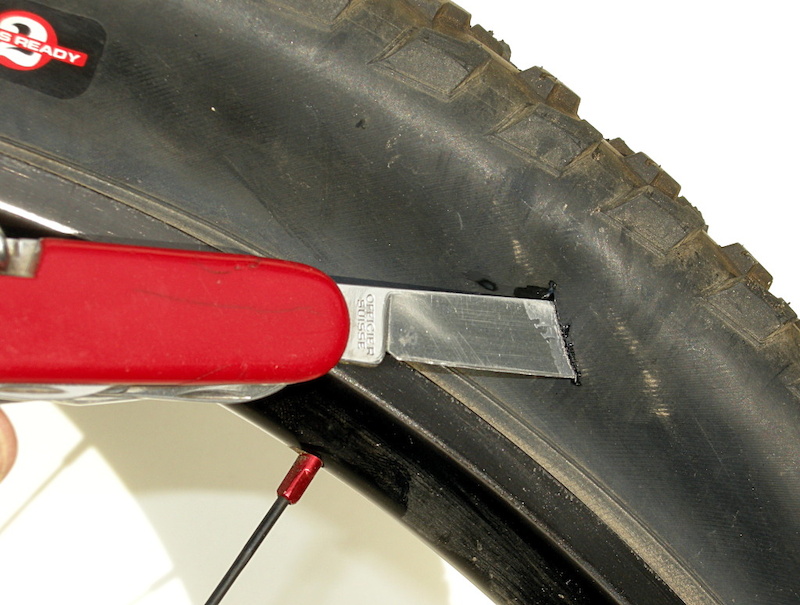Asked
Modified 4 years, 11 months ago
Viewed 20k times
This morning I discovered that my commuter folding bike had a bad flat tire, and I ran out to buy a new tube, no problem. I didn't notice until after I'd changed the tube that the tire sidewall was beginning to crack.
I need this bike for my commute tomorrow, and am not going to be able to get a replacement tire on short notice. Is there anything I could do to reinforce the sidewall to minimize the chance of a catastrophic flat tomorrow?
I saw something on Answers.com about supergluing tears in tires, but I don't know if that's good advice or not.
2
You need to "boot" the inside of the tire with a dollar bill or purpose-made tire boot or some such. You shouldn't glue the boot in place, but you may use a small dab of glue to keep it from shifting while you install the tube and inflate the tire.
2
I usually carry a park tool emergency boot in case of big tears on the tires. When in need and desperate, a dollar bill along the inside of the tire where the crack or tear is on the tire does the job too. Just keep in mind that it's a very temporary fix and a replacement tire should be bought as soon as humanly possible.
Just make sure not wrap the dollar bill around the entire inner tube.
Be Safe and Be Green.
3
I use a standard tire patch on the inside of the tire to fix this. It's only a temporary fix, but it works very well.
3
I have my doubts about using superglue. Superglue typically dries into a stiff,hard non-flexible film. The tire bends and flexes and the glue will fail. If the crack is a small age crack in the side wall and doesn't go through the cord inside the tire, I would just put in the tube and ride. If the cut/crack goes all the way through the cord and is visible inside the tire you can cut a piece of the old tube and glue it over the split on the inside of the tire. If you don't have anything but preglued patches use one or two of them to cover the hole. Install the tube and inflate the tire. Check the tire in the repair area to see if the crack is spreading. I have used a tire boot (it basically a large patch) on mountain bike tires with success. MTB tires run at much lower pressures. The boots are available at your local bike shop and are worth having for situations like these.
Superglue typically dries into a stiff,hard non-flexible film. The tire bends and flexes and the glue will fail. If the crack is a small age crack in the side wall and doesn't go through the cord inside the tire, I would just put in the tube and ride. If the cut/crack goes all the way through the cord and is visible inside the tire you can cut a piece of the old tube and glue it over the split on the inside of the tire. If you don't have anything but preglued patches use one or two of them to cover the hole. Install the tube and inflate the tire. Check the tire in the repair area to see if the crack is spreading. I have used a tire boot (it basically a large patch) on mountain bike tires with success. MTB tires run at much lower pressures. The boots are available at your local bike shop and are worth having for situations like these.
3
I'm assuming you lived through your commute, but for posterity if your tire has a sidewall tear because it's so dry-rotted that it's failing on it's own, you need to skip the commute and fire up the car or take the bus.
If you've got a small sidewall cut you can actually use the rubber glue type patches to seal the hole from the inside. I regularly do this for tubeless punctures that are too big for the Stan's goop to seal. Same principle for tires with tubes.
For bigger punctures you can use a purpose made tire boot. Basically the same as the tube patch, only bigger.
In a pinch, a folded up bill, a candy bar wrapper, whatever's handy. I've seen people stuff leaves in a cut tire to get to a tube to stay in - mixed results on that one.
0
If possible, please use alternative transportation.
If you are really really persistent and want to repair your commuter bike rather than using other means, there are glues and patches available online (even on the high-street shops). I have seen them and they are okay for a normal dry weather day to fix the tyre and keep going. BUT I STILL WOULD NOT RECOMMEND THEM because if the weather is hot, they might affect the tyre. It is always good to have a backup tyre, but hey! you cannot predict that it will have trouble when you are at home (may be at work?).
It is always good to have a backup tyre, but hey! you cannot predict that it will have trouble when you are at home (may be at work?).
The best way to preempt and avoid this kind of problem is to check your tyres every 2-3 months, or earlier if you have had quite a rough tarmac to go through recently. Tyre cracks are also affected when you keep your bike outside overnight for a long period. Atmospheric pressure, humidity, temperature, etc. affect the tyres. keep that in mind.
I hope this helps
I remember I had ~ 2 inch tear on my Kenda K-Rad. I glued it from the inside with a rubber adapter from a light reflector and it did a good job for another half a year. It's totally not the end of the world and in the worst case scenario you will simply stuck with flat (your tube will escape from the tear and pop like a baloon).
1
In the past, I have tried a few different things:
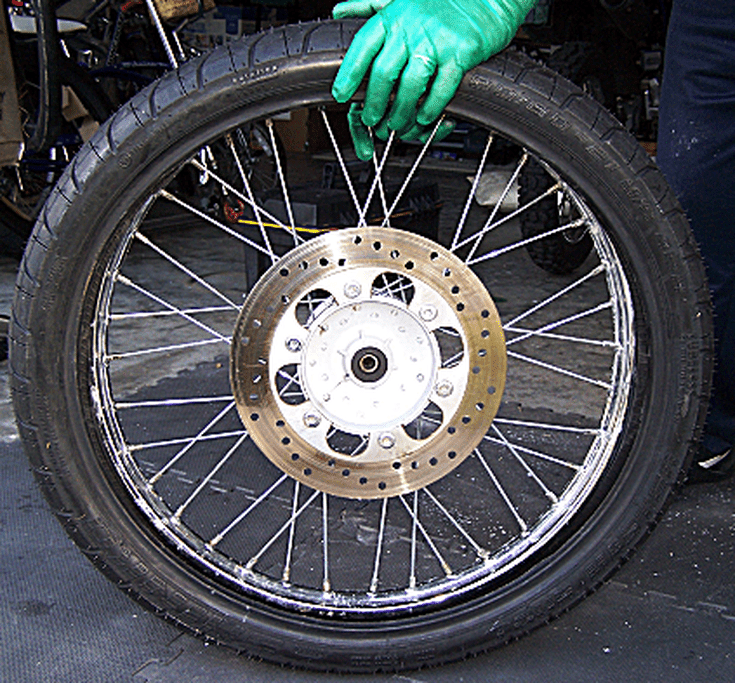
1
Sign up using Google
Sign up using Facebook
Sign up using Email and Password
Required, but never shown
Required, but never shown
By clicking “Post Your Answer”, you agree to our terms of service, privacy policy and cookie policy
Asked
Modified 6 years, 4 months ago
Viewed 7k times
On my latest ride I managed to put a cut in the sidewall of my front tyre (Specialized S-Works Purgatory 26x2. 2"). The sealant (Stan's No Tubes) didn't manage to seal the cut, presumably because the sealant lines the tread and not the sidewall.
2"). The sealant (Stan's No Tubes) didn't manage to seal the cut, presumably because the sealant lines the tread and not the sidewall.
While I was out on the trail I re-inflated the tyre and lay the bike on its side to seal the cut. Everything seemed fine until I got on the bike to ride it again, as the tyre rolled it deformed slightly and opened up the cut again. I managed to get home but had to re-inflate the tyre a couple of times to get there.
This post suggests the use of a Tire Boot but on the Park Tool site it suggests that it is only good for tubed tyres: "...in any tubed tire...".
As you can see, the cut seems fairly minor but the sidewall is quite thin, is there any chance of repair or is it time to invest in some new rubber?
6
The solution to fix this was in the Pinkbike article suggested by @Batman in the comments to the question.
If you buy a radial tyre patch designed for a car then chances are it'll be plenty big enough to patch a hole in a bike tyre. I just went for some cheap ones on eBay. Add the vulcanising glue (plenty of it) to the inside of the tyre and stick the patch on. To be extra safe I added some glue around the edges of the patch after it was in place too.
As you can see in the photos below, there is almost no noticeable bulge on the tyre.
I've ridden the bike a couple of times since reinstalling the tyre and it has been flawless, no problems with the tyre and you certainly can't feel the patch when you're riding.
I realise there is no single solution that will work for everyone who finds themselves with a cut on the sidewall of their tubeless tyre but this solution worked very well for me.
I don't know "the" answer, but a couple of ideas come to mind:
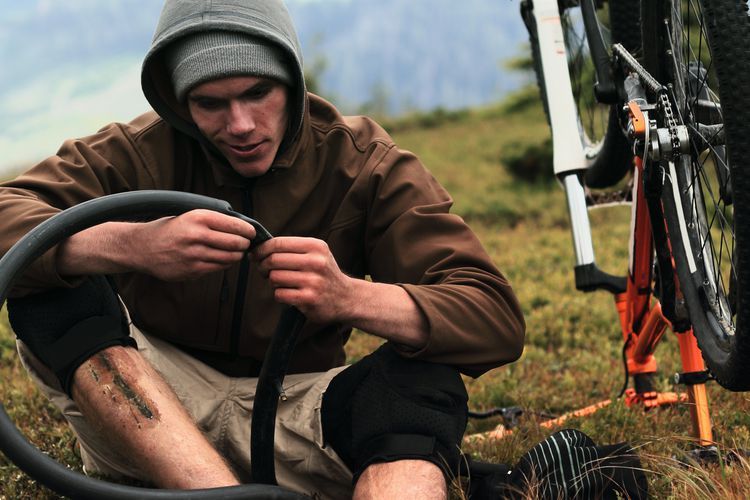 Having the patch on the inside means that air pressure in the tire helps to hold it in place.
Having the patch on the inside means that air pressure in the tire helps to hold it in place.Putting in a tube changes the role of the tire from air container to tube restrainer. That cut doesn't look too bad – but do look at the inside to see how much damage was done. If the threads of the casing are cut I think you may have trouble keeping the cut from growing.
I think the biggest problem you'll run into here is that the sidewalls are going to flex a lot and it may be necessary to have some kind of mechanical patch to prevent the cut from reopening if you continue running the tires without tubes.
If that is your front tire, I'd think about moving it to the back if you try patching it. The consequences of a blowout on the front are much worse that the rear.
BTW - clever move to put the bike on its side to get the sealant to work.
6
Sign up using Google
Sign up using Facebook
Sign up using Email and Password
Required, but never shown
Required, but never shown
By clicking “Post Your Answer”, you agree to our terms of service, privacy policy and cookie policy
 ru
ru Among the possible damage to a bicycle tire, there are those in which the replacement of the camera does not help. In a note, I will share this experience in repairing the sidewall of a Michelin Pro4 Service Course V2 bicycle tire.
A couple of years ago I was looking for road bike tires, more details here: Road bike tires, I want to go fast and not break through. I chose Michelin Pro4 Service Course V2 tires (for two bicycles on the farm). As for resistance to a puncture, there was confidence that there would be no regular problems on those roads on which we ride. Indeed, for a season and a half, not a single puncture. Even such an insidious option as a metal cord from truck tires (resembling a small needle) was not caught. More precisely, I got caught once, but after a side cut.
But there were no illusions about the side wall. In half the cases, tires of this level of rolling fail not due to wear, but due to a side cut. This is due to the fact that the side wall is soft, thin, elastic. Otherwise, it will not roll, too much energy will be taken to compress and straighten the tire near the “contact patch”.
Otherwise, it will not roll, too much energy will be taken to compress and straighten the tire near the “contact patch”.
The sides of the tires are usually cut with pebbles, which are often washed onto the road from the side of the road after rain. Or they are just scattered there in some places. The interaction of a pebble with a tire is worthy of a separate study. If in such a place along the road there is a metal chipper, then the pebbles sometimes hit it quite loudly, as if they were fired from a slingshot point-blank. That is, the pebble, as it were, is captured by the sidewall of the tire when the wheel hits, and then, when released, it is fired with very decent energy. Probably, if something goes wrong and the energy of the pebble turns out to be directed to the sidewall of the tire, and the pebble itself turns out to be with a sharp edge, then the tire may not withstand it. And it will not be a puncture, but a “bullet wound” 🙂
If possible, I try not to run into the pebbles on purpose, but since I am the “second number”, this is not always possible. In general, one fine day at the 18th kilometer of the planned 70, a shot rang out from under the rear wheel, as if it had run into a primer. There is a hole in the sidewall of the tire with a caliber of 7.62 mm, and in the chamber, of course, which exploded.
In general, one fine day at the 18th kilometer of the planned 70, a shot rang out from under the rear wheel, as if it had run into a primer. There is a hole in the sidewall of the tire with a caliber of 7.62 mm, and in the chamber, of course, which exploded.
I note that the tire was inflated almost to the allowed maximum.
Maximum pressure - 116 psiWith a maximum pressure of 116 psi (marked on the side surface), the tire pressure calculator gives for my current "curb weight" the required pressure of 115 psi, which was "driven in". The tire itself passed one season on the front wheel (that is, in a gentle mode), we can say that it did not even squash. This is her second season in which she is working on pushing a curb weight from behind.
What should I do if I catch a side cut? On the Internet, this is chewed in more than detail, so I was well prepared for this. Just in case, I will list three options in descending order of the reliability of monitoring the situation.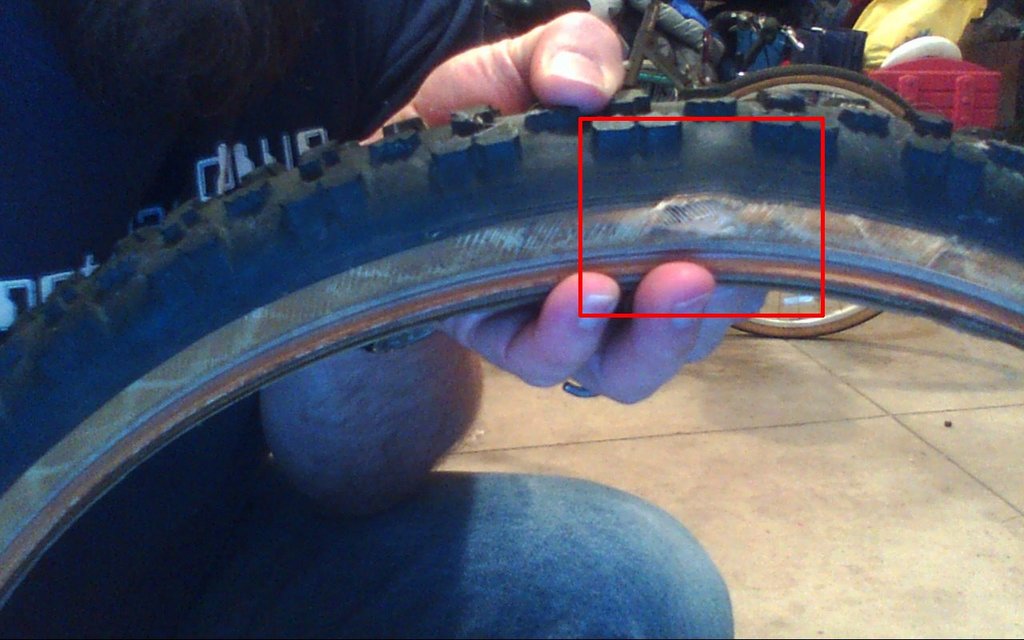
I stuck three layers of adhesive tape to the inside of the tire. When stuffing the necessary “nuts”, a small hernia appeared in place of the hole, but the camera was not at risk. One could say that I had a great ride up to the planned 70 km, but no, as I already mentioned, I also caught a wire-needle. I drive two cameras (because we ride together), so the cameras were enough for this trip “just right” 🙂
When stuffing the necessary “nuts”, a small hernia appeared in place of the hole, but the camera was not at risk. One could say that I had a great ride up to the planned 70 km, but no, as I already mentioned, I also caught a wire-needle. I drive two cameras (because we ride together), so the cameras were enough for this trip “just right” 🙂
Repair of the sidewall of a bicycle tire is described quite well on the Internet, so I will hardly be original. However, there are a number of points that you need to pay attention to. The general principle is that during the repair, a sufficiently strong patch is glued inside, which should not allow the camera to squeeze out the hernia. But at the same time, of course, you need to say goodbye to the softness of the sidewall in this place. That is, the wheel will roll clearly worse. Yes, and the patch from the inside can fall off, because all the time it will either bend or unbend. Therefore, generally speaking, such a repair is not recommended. You could probably say the same about the bike. And on a car, in my experience, such repairs are simply prohibited, the tire is thrown out.
You could probably say the same about the bike. And on a car, in my experience, such repairs are simply prohibited, the tire is thrown out.
I chose the patch from a durable rubber found on the farm. I think that ordinary patches for punctures in cells are categorically not suitable, because they are easily stretched. Ideally, the rubber for such a patch should be reinforced with fabric, but I didn’t have one. The one that was found, to the touch is much denser than the patches for the cameras, it looks like the rubber of the sidewall of a tire. For some reason, it was attached to the ski helmet 🙂
Before gluing the patch, the hole must be sewn up. Not so that the threads hold the gap, but so that the entire problem area sticks evenly to the patch, which will hold the load. The threads can then fray during operation, this is no longer important.
I glued it as usual (sanded it, degreased it, the first layer of glue was dry, the second one was working, I pressed it for a day).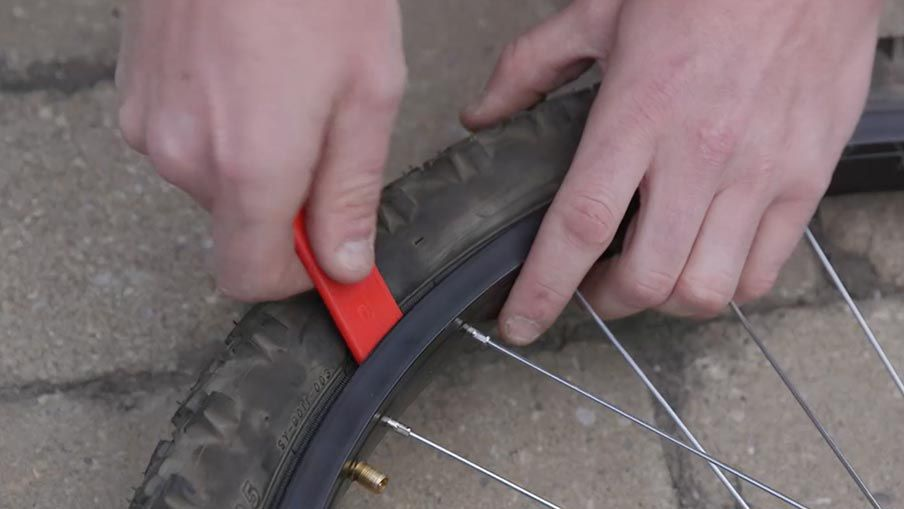 It turned out that the glue did not stick to the Michelin compound, everything remained on the patch. Maybe the glue was bad, universal based on gasoline, judging by the smell. I repeated the procedure with cyacrine glue (superglue). It stuck great. The edges of the patch were “nullified” with a dremel with a “skin circle” type nozzle. Just in case, I smeared the threads on the outside with cyacrine glue.
It turned out that the glue did not stick to the Michelin compound, everything remained on the patch. Maybe the glue was bad, universal based on gasoline, judging by the smell. I repeated the procedure with cyacrine glue (superglue). It stuck great. The edges of the patch were “nullified” with a dremel with a “skin circle” type nozzle. Just in case, I smeared the threads on the outside with cyacrine glue.
So far so good, but just in case I carry a spare tire with me.
Spare tiredid not notice any deterioration in rolling, although, in addition to the deterioration in rolling parameters due to the internal blotch, I still installed a conventional butyl bladder instead of a latex one. To be honest, suspected as well, but now there is something to think about additionally :) DIY
After three months of operation of a children's tricycle, I ran into trouble: the sidewall of the tire burst. An attempt to buy a part of the same size was unsuccessful, and I didn’t want to “change shoes” for the whole bike.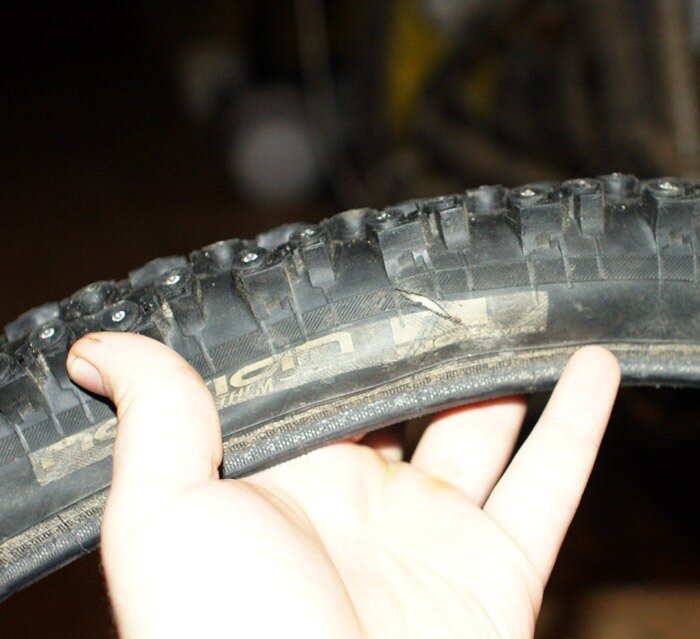 Therefore, I fixed the defect myself.
Therefore, I fixed the defect myself.
I made a hook from an awl, splashing its sting with a hammer (photo 1). At hand was a white nylon thread, sewed up the torn area with it (photo 2).
Note
The thread must be thick so as not to cut through the tire, non-stretching and woven from non-; how many cores, kapron (natural can; tear during operation).
For reliability, I decided to strengthen the seam. From the inside, I smeared the tire with liquid nails. I laid a layer of gauze on top (you can use a bandage) and missed it again (photo 3)
Installed a camera in the tire and pumped it up (photo 4). So liquid nails are evenly distributed over the inside of the tire and fall directly into the seam.
A day later, when everything was dry, I assembled the wheel. Since I sewed up the gap with a white thread so that the seam was not conspicuous, I painted it over with shoe polish (you can paint it from a spray can).
As practice has shown, the tire has been serving perfectly for half a year.
Tires in a bicycle have to be changed most often. In the store we are faced with a huge assortment of bicycle tires. To make the right choice, I propose to understand its main types and their features.
Slicks
+ Low resistance (good rolling).
+ No vibration when driving on asphalt.
+ Low noise level.
Poor stability on muddy roads and when driving on rough terrain -
Weak shock suppression when hitting bumps.
Semi-slicks
+ Versatile.
+ Acceptable freewheel. + Good off-road performance.
- Despite the presence of a tread, not intended for riding on rough terrain.
- Slight vibration when driving) on asphalt.
Heavy duty rubber
+ Excellent off-road performance.
+ Softening shock when overcoming bumps.